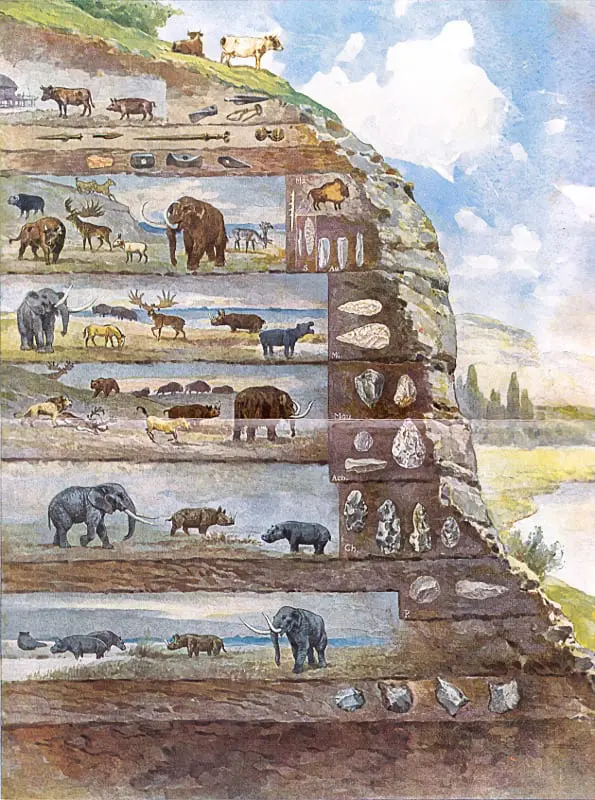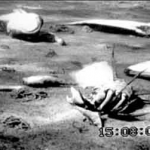The failure of the fossil record to yield any evidence of the long evolutionary sequences of transitional life forms predicted by Charles Darwin and evolutionary speculations is now common knowledge. It is not only acknowledged by creationists, but also acknowledged nearly universally by evolutionists as well (albeit begrudgingly). This state of affairs is simply empirical fact; there are zero transitional forms documented in the fossil record other than what can be classified as intraspecies variations, as for example various types of dogs or cats, or examples of what are unsupported speculation about an organism’s place in the mythical “tree of life.”
This is what creationists expected and predicted. Evolutionists, on the other hand, not expecting this, have sought for explanations (rationalizations?) that could preserve evolutionary speculations. Ever since Darwin, the standard evolutionary “party line” to account for the lack of transitional forms among fossils has been to claim that the fossil record is miserably incomplete. Said Darwin in his now very famous quote: “The explanation lies, I believe, in the extreme imperfection of the fossil record.” I will dispute Darwin’s claim of the extreme imperfection of the fossil record below, but first, for argument’s sake, let’s accept the claim that the fossil record is miserably incomplete compared to the vast number of species that have ever existed. Even if this were true, would this solve the evolutionists’ problem? The answer is, No it would not because of the systematic nature of the gaps. Michael Denton, as usual, is most illuminating:
“The fundamental problem in explaining the gaps in terms of…the imperfection of the record is their systematic character—the fact that there are fewer transitional species between the major divisions than between the minor…and this rule applies universally throughout the living kingdom to all types of organisms…But this is the exact reverse of what is required by evolution. Discontinuities we might be able to explain away in terms of some sort of sampling error but their systematic character defies all explanation. If the gaps really were the result of an insufficient search, or the result of the imperfection of the record, then we should expect to find more transitional forms between mouse and whale than between dog and cat.”—Evolution: A Theory in Crisis—pg. 191-192, bold emph. supp.
This is an exceedingly striking and amazing fact, and a consideration that I personally regard as conclusively and formally falsifying the Darwinian schema. There is simply no possibility whatsoever of random mutation and natural selection producing this state of affairs. If evolution occurred, it assuredly did not occur by Darwin’s preferred mechanism. Given the significance of this consideration, I am very surprised that it is not the object of much more frequent comment than it is among creationists.
Concerning the “imperfection of the fossil record,” we have, of course, discovered many new species of living creatures in the fossil record since Darwin’s time, none of them suggesting sequential progression, totaling to about 100,000 known species now (Denton, pg. 185), but this does not mean that the knowledge of Darwin’s time was without significance. Enough paleontology had been done to give a general overall picture. And the paleontologists’ response to Darwin was that his speculations (i.e., continuously evolving and “inconceivably great” number of transitional forms) were not at all what they saw in the fossil record, but only distinct species throughout the entire thickness of a geologic stratum, some of which existed in great abundance. (See, Darwin’s Creation Myth: What it is, How it has Proved “Unfit,” Why it Survives, by Alexander Mebane, pg. 8)
How is it that random processes could have so specifically eliminated all the transitional species in the fossil record leaving only distinctly isolated species behind? This would be virtually miraculous and we know what the secular evolutionists think about miracles! Here again, in regard to this particular, Darwin cannot be excused due to lack of scientific progress in his time. Darwin went so far as to make the baseless claim that a species was not a real thing but an “ephemeral manifestation” in the long and continuous chain of evolutionary change!
Consider just one example to elucidate this point: we have in museums around the world approximately one thousand complete skeleton fossils of bats. On Darwinian assumptions, there would be, over millions of years, innumerable creatures which were not bats but were the ancestors of bats before full-fledged bats emerged, beginning with a creature that was, say, 1/1,000th bat, then a creature 1/500th bat, then 1/100th bat, then 1/50th bat, then 1/10th bat, then 1/5th bat, then ½ bat, then 3/4th bath, then finally a full-fledged bat. And this progression I just proposed is, in Darwinian terms, and exceedingly abbreviated version of what “must” have happened. The gradation would have been even finer by many, many orders of magnitude. How is it that random fossilization processes could have so fully and completely eliminated all of these precursors to bats leaving zero examples, yet leaving 1000 (complete) fossils of full-fledged bats? (And this doesn’t even factor in all of the partial bat fossils which are more abundant than the complete skeletons.) How is it conceivable that random fossilization events so selectively bequeathed to us so many bat fossils but no precursors? What are the mathematical odds? I’m no mathematician, but the likelihood of such a scenario on Darwinian assumptions must be trillions to one! And this scenario is replicated across the whole spectrum of living organisms which have left us any significant number of fossils. I assert that this fact is a formal and conclusive falsification of Darwinian speculation.
All of this is by way of introduction to what I really want the reader to take away from this article, namely, the relative completeness of the fossil record. The relative completeness of the fossil record is not something discussed very much by evolutionists (or—mysteriously—by creationists either). On page 190 of Evolution: A Theory in Crisis, Michael Denton presents a quantified table titled “The Adequacy of the Fossil Record” of living organisms compared to fossilized specimens and the comparison is amazing! The reader should ponder this table at great length until the full significance of it settles in. Consider:
“Number of living orders of terrestrial vertebrates: 43
Number of living orders of terrestrial vertebrates found as fossils: 42
Percentage fossilized: 97.7%
“Number of living families of terrestrial vertebrates: 329
Number of living families of terrestrial vertebrates found as fossils: 261
Percentage fossilized: 79.1%
“Number of living families of terrestrial vertebrates excluding birds: 178
Number of living families of terrestrial vertebrates found as fossils excluding birds: 156
“Percentage fossilized: 87.7 %”
Denton cites Darwin again:
“That the geological record is imperfect all will admit; but that it is imperfect to the degree required by our theory, few will be inclined to admit?” (pg. 191)
So I ask: Then why did Darwin try to appeal to the “extreme imperfection” of the fossil record when he knew there were so few who would agree with such a claim, especially paleontologists? I’ll spare Darwin the posthumous accusations and let the reader answer the question.
Denton’s table is striking affirmation of the great extent of preservation of the record of the whole panorama of life as fossils. The fossil record of the kinds of past living creatures is not poor; it is, in fact, quite rich. And this poses an insurmountable problem for Darwinists. Not only are the presumed transitional species not preserved as fossils, it is not possible that they ever existed to be preserved in the first place. Both the living world AND the fossil record are testaments to the uniqueness of species and their biological isolation from one another. It should not go without being explicitly stated that this scenario is perfectly consistent with the biblical declarations by Moses in the book of Genesis of the independent creation of various kinds of living creatures.
Now, extrapolating this out even further, I also find all of this rather relevant and significant to the question of how long life has existed on the earth. I’ll content myself with a couple questions for the reader to ponder: If, in fact, millions, or hundreds of millions, or billions of years have elapsed since life first appeared on earth, then would we not expect something roughly the equivalent of what some evolutionists claim is the state of affairs, namely, that the fossil record would be in a state of “extreme imperfection?” Moreover, would not many more species have become extinct by a process of attrition over very great stretches of time? And if the fossil record is relatively full and complete, is this not another very strong indicator of a young history of life on the earth?
My next article, “BEWARE THE INTELLIGENT DESIGN CROWD!,” will examine the contrast between the Intelligent Design movement (ID) and biblical creationism.








dear Tom. how many fossils should be under our feet if the earth were billions of years and all those many life-cycles were required for evolution and today we only have 10% of the species that have existed before (I read this somewhere!)? do the conditions for the formation of fossils happen very rarely? tks,
Hello, Charles. According to Charles Darwin, the number of fossils and fossil SEQUENCES under our feet according to evolutionary speculation should be “inconceivably great”! The conditions for the formation of fossils would appear to be quite rare and include rapid burial and an extensive catastrophe. This is why the existence of fossilization of so many living families of terrestrial vertebrates is so telling. Denton did not mention the obvious in his book, but this fact testifies to a YOUNG earth . Thank you for your response.
Thanks for your article! Like you said, I haven’t seen others writing on this topic, so it fills a perfect void.
My sister and I are doing a lot of research on creation to teach where we live now in Peru, so I’m even happier that there are lots of articles in Spanish so people can read them for themselves!